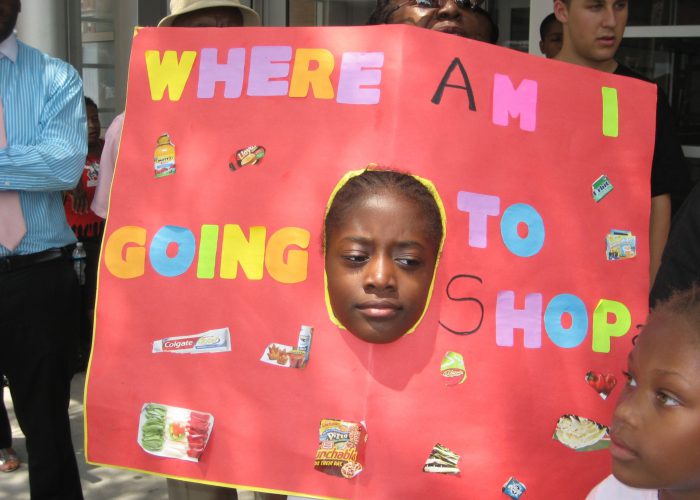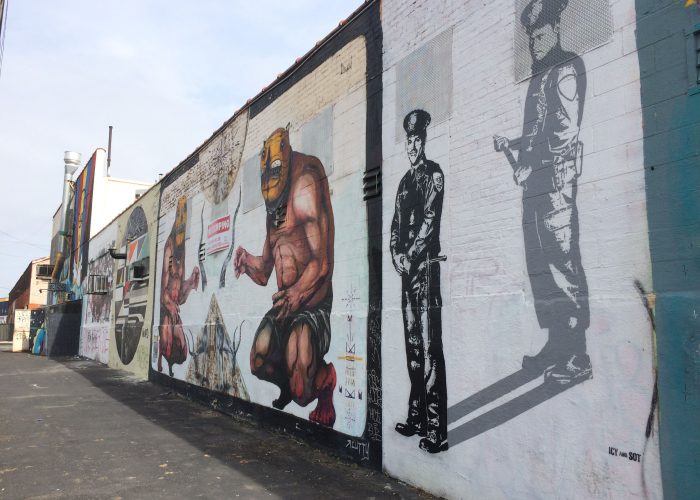Chapter 2: Blackout
 The old Fulton Mall: sneakers, jewelry, cellphones, and tattoos, all under one roof. One white Park Slope resident told filmmaker Kelly Anderson: “I don’t know how to interact with it, and I think they should just make it go away” — then acknowledged, “people shop there, so maybe there’s stuff for African Americans?”
The old Fulton Mall: sneakers, jewelry, cellphones, and tattoos, all under one roof. One white Park Slope resident told filmmaker Kelly Anderson: “I don’t know how to interact with it, and I think they should just make it go away” — then acknowledged, “people shop there, so maybe there’s stuff for African Americans?” One of the threatened houses on Duffield Street off the Fulton Mall. “They renamed my block Abolitionist Place,” declared resident Joy Chatel, “but they’re taking the descendants of Frederick Douglass out of their homes! How much evidence do they want, black people in the basement?”
One of the threatened houses on Duffield Street off the Fulton Mall. “They renamed my block Abolitionist Place,” declared resident Joy Chatel, “but they’re taking the descendants of Frederick Douglass out of their homes! How much evidence do they want, black people in the basement?” The downtown Brooklyn rezoning was sold as a way for New York City to compete with New Jersey for office space. The commercial development mostly never materialized, but hotels and condo towers did. “If our views are obscured," said “Downtown Brooklyn Partnership president Joe Chan, "we’ll know we’ve done a good job.”
The downtown Brooklyn rezoning was sold as a way for New York City to compete with New Jersey for office space. The commercial development mostly never materialized, but hotels and condo towers did. “If our views are obscured," said “Downtown Brooklyn Partnership president Joe Chan, "we’ll know we’ve done a good job.” Protest against developer/mayoral candidate John Catsimatidis's plans to demolish businesses on Myrtle Avenue to erect new condo towers, July 2008. Catsimatidis had previously joked that when he visited his properties there he liked to bring two guns, “just in case one of the guns runs out of bullets.”
Protest against developer/mayoral candidate John Catsimatidis's plans to demolish businesses on Myrtle Avenue to erect new condo towers, July 2008. Catsimatidis had previously joked that when he visited his properties there he liked to bring two guns, “just in case one of the guns runs out of bullets.” Protest against John Catsimatidis's plans to demolish businesses on Myrtle Avenue to erect new condo towers, July 2008. “All of a sudden, because we’re close to Manhattan, folks want to bring money into the community," said Fort Greene activist Kevin Powell. "But we’re saying: Don’t displace us. We have a right to be here.”
Protest against John Catsimatidis's plans to demolish businesses on Myrtle Avenue to erect new condo towers, July 2008. “All of a sudden, because we’re close to Manhattan, folks want to bring money into the community," said Fort Greene activist Kevin Powell. "But we’re saying: Don’t displace us. We have a right to be here.” After the downtown Brooklyn rezoning, landlords began seeking more upscale stores. “You walk down Fulton Street now, it’s a completely different place,” said FUREE organizer Michael Higgins.
After the downtown Brooklyn rezoning, landlords began seeking more upscale stores. “You walk down Fulton Street now, it’s a completely different place,” said FUREE organizer Michael Higgins. Three years after the 2008 economic crash and seven years after the rezoning, many construction sites in downtown Brooklyn remained empty pits. When the crash hit, said local barber Jack Fuzailov, “Everything just froze. And a lot of those people that had stores lost it for nothing.”
Three years after the 2008 economic crash and seven years after the rezoning, many construction sites in downtown Brooklyn remained empty pits. When the crash hit, said local barber Jack Fuzailov, “Everything just froze. And a lot of those people that had stores lost it for nothing.” Demolition of buildings on Bridge Street in the wake of the downtown Brooklyn rezoning, 2011.
Demolition of buildings on Bridge Street in the wake of the downtown Brooklyn rezoning, 2011. Apartments facing Maria Hernandez Park in Bushwick, which went from drug war zone in the 1990s to a fast-gentrifying district in the 2000s. Average rents in Bushwick jumped by 60% between 1999 and 2007.
Apartments facing Maria Hernandez Park in Bushwick, which went from drug war zone in the 1990s to a fast-gentrifying district in the 2000s. Average rents in Bushwick jumped by 60% between 1999 and 2007. Rheingold Gardens, the last major housing development built by Bushwick Ridgewood Senior Citizens Council, founded by Bushwick power broker Vito Lopez.
Rheingold Gardens, the last major housing development built by Bushwick Ridgewood Senior Citizens Council, founded by Bushwick power broker Vito Lopez. "Hipster graffiti" in the East Williamsburg Industrial Park, which became settled by young artists and musicians in the wake of the 2004 rezoning that led to the redevelopment of the Williamsburg waterfront. "The idea was it was cheap and available and we could make noise," said musician Jesse Jarnow.
"Hipster graffiti" in the East Williamsburg Industrial Park, which became settled by young artists and musicians in the wake of the 2004 rezoning that led to the redevelopment of the Williamsburg waterfront. "The idea was it was cheap and available and we could make noise," said musician Jesse Jarnow. "Hipster graffiti" in the East Williamsburg Industrial Park, which became settled by young artists and musicians in the wake of the 2004 rezoning that led to the redevelopment of the Williamsburg waterfront.
"Hipster graffiti" in the East Williamsburg Industrial Park, which became settled by young artists and musicians in the wake of the 2004 rezoning that led to the redevelopment of the Williamsburg waterfront. Bodegas and political murals collide in the new Bushwick.
Bodegas and political murals collide in the new Bushwick. Graffiti on a loft building in the East Williamsburg Industrial Park, 2014. One building on McKibben Street attracted so many young people it became known locally as The Dorms.
Graffiti on a loft building in the East Williamsburg Industrial Park, 2014. One building on McKibben Street attracted so many young people it became known locally as The Dorms. Joy Chatel's Duffield Street underground railroad house (at far left) was ultimately spared, though dwarfed by a new hotel next door.
Joy Chatel's Duffield Street underground railroad house (at far left) was ultimately spared, though dwarfed by a new hotel next door. An apartment building on Albee Square West (originally Gold Street) was seized by the city via eminent domain following the downtown Brooklyn rezoning, and 40 families were evicted.
An apartment building on Albee Square West (originally Gold Street) was seized by the city via eminent domain following the downtown Brooklyn rezoning, and 40 families were evicted.
Buy "The Brooklyn Wars" paperback
Buy "The Brooklyn Wars" ebook

